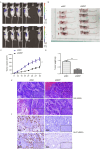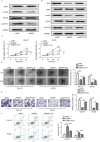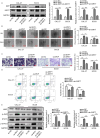SIRT7-Mediated MVP Desuccinylation Facilitates Tongue Squamous Cell Carcinoma Progression by Activating JAK2/STAT3 Pathway
- PMID: 40586636
- PMCID: PMC12340476
- DOI: 10.1002/cbin.70048
SIRT7-Mediated MVP Desuccinylation Facilitates Tongue Squamous Cell Carcinoma Progression by Activating JAK2/STAT3 Pathway
Abstract
Major vault protein (MVP) plays a contributing role in multifarious cancers, and then its role in Tongue squamous cell carcinoma (TSCC) is uncomprehending. This study aimed to investigate the regulatory effect of MVP on malignant behavior of TSCC cells and its mechanism. We first pointed out the abnormal upregulation of MVP in tumor tissues by immunohistochemistry, western blot, and reverse transcription-quantitative polymerase chain reaction assays. Depletion of MVP hindered TSCC cell viability, migration, and invasion and accelerated apoptosis. Mechanistically, depletion of MVP inactivated Janus Kinase 2 (JAK2)/Signal Transducer and Activator of Transcription 3 (STAT3) pathway. Coumermycin A1 (CA1), a JAK2 agonist, was used to trigger JAK2/STAT3 signaling. Functional experiments demonstrated that CA1 significantly counteracted the inhibitory effects of MVP silencing on cell proliferation, invasion, and migration, as well as the stimulatory effects of MVP silencing on cell apoptosis. Moreover, we discovered that MVP undergoes succinylation and identified Sirtuin 7 (SIRT7) as the desuccinylase for MVP. Addition of SIRT7 promoted the protein stability of MVP in TSCC cells. Further, addition of MVP expedited the viability, migration, and invasion and suppressed apoptosis of TSCC cells, which was partly neutralized following depleted SIRT7. Our findings revealed that MVP desuccinylated by SIRT7 accelerated TSCC progression via regulating JAK2/STAT3 signaling.
Keywords: JAK2/STAT3 pathway; MVP; SIRT7; progression; tongue squamous cell carcinoma.
© 2025 The Author(s). Cell Biology International published by John Wiley & Sons Ltd on behalf of International Federation of Cell Biology.
Figures







References
-
- Bray, F. , Ferlay J., Soerjomataram I., Siegel R. L., Torre L. A., and Jemal A.. 2018. “Global Cancer Statistics 2018: Globocan Estimates of Incidence and Mortality Worldwide for 36 Cancers in 185 Countries.” CA: A Cancer Journal for Clinicians 68, no. 6: 394–424. - PubMed
-
- Colella, G. , Rauso R., De Cicco D., et al. 2021. “Clinical Management of Squamous Cell Carcinoma of the Tongue: Patients Not Eligible for Free Flaps, a Systematic Review of the Literature.” Expert Review of Anticancer Therapy 21, no. 1: 9–22. - PubMed
-
- Colevas, A. D. , Yom S. S., Pfister D. G., et al. 2018. “Nccn Guidelines Insights: Head and Neck Cancers, Version 1.2018.” Journal of the National Comprehensive Cancer Network 16, no. 5: 479–490. - PubMed
-
- Deng, H. , Gong X., Ji G., Li C., and Cheng S.. 2023. “KIF2C Promotes Clear Cell Renal Cell Carcinoma Progression via Activating JAK2/STAT3 Signaling Pathway.” Molecular and Cellular Probes 72: 101938. - PubMed
MeSH terms
Substances
LinkOut - more resources
Full Text Sources
Miscellaneous

